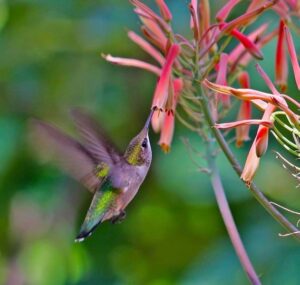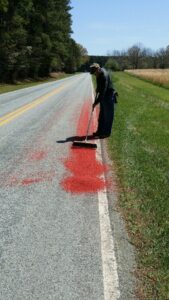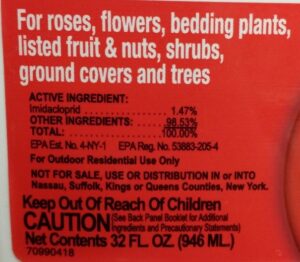Neonics, Bee-Killing Insecticides that also Harm Birds
Author: Elizabeth D. Hilborn, DVM, beewellvet.com
With spring planting season coming up soon, now is a good time to think about the neonicotinoid insecticides, or ‘neonics’ for short.
Neonics are well-known as bee killers—honey bees and native bees alike. Neonics have been linked to bee deaths, to poor bee navigation and reproduction, and to diminished colony survival1.
We may be most familiar with honey bees producing honey. But now, more profitably, honey bees provide pollination services, earning beekeepers in the United States hundreds of millions of dollars per year as they travel with their bee colonies to pollinate fruit and nut crops2. Because of their economic importance to agriculture, US honey bee colonies have been assessed annually since 2006.
Bees function as the proverbial ‘canary in the coal mine’ for insect life, and recent honey bee colony losses are high: since 2006, surveys report annual losses of 28% to 43% 3.
But what does this have to do with birds?
Unfortunately, there is increasing evidence that neonics are contributing to songbird decline4.
Neonics are now the most commonly used class of insecticides in the world. Neonics’ major uses include use as a general landscape insecticide, and for plant protection in greenhouses and nurseries. But by far, the largest use is as a seed coating pesticide. Neonics are used to coat seeds of many row crops, notably corn, soybean, and cotton5.
Neonics are water soluble and persistent in soil so they can be active for years after application; they have been detected in surface water, ground water, and drinking water6,7. Neonics are systemic, meaning that when a plant is treated, the whole plant contains the insecticide, So leaves, buds, nectar and pollen may all contain the toxin. Neonics are potent, meaning that very small amounts are effective at killing insects.
Birds are harmed by neonics in at least two ways: 1) neonics reduce the availability of bird food by reducing insect populations; 2) neonics can poison birds directly.
Neonics can contaminate water and plants used by insects. Important plants for insects include: ‘pollinator plants’ that provide nectar and pollen to insects; and other plants such as trees that insects use for food. Insects that consume treated plants or collect pollen or nectar from treated plants can be harmed. Insects can be directly poisoned and die, or neonics can impair reproduction. Either way, insect populations can be diminished by neonic exposure. Neonics have been implicated as one of the major contributors to the ‘insect apocalypse’.
The list of potentially impacted insects includes many that are sources of food for birds: butterflies, wasps, bees, flies, and moths. Caterpillars of butterflies and moths are an essential food source for nestlings during the breeding season. Neonics can reduce these important insect food sources and reduce birds’ reproductive success and juvenile survival via malnutrition8.
 Hummingbird feeding at cardinal honeysuckle
Hummingbird feeding at cardinal honeysuckle Neonics can harm birds directly. Margaret Eng and colleagues from the University of Saskatchewan recently reported experimental evidence of loss of navigational ability and body condition among neonic-exposed white-crowned sparrows9. Studies of sparrows and hummingbirds living in agricultural areas have documented biological evidence of neonic exposure; birds’ deaths have been reported after they consumed neonic coated seeds during planting season10,11,12,13. Birds are exposed directly to neonics by eating spilled coated seeds, by feeding upon contaminated plant material/nectar or by drinking contaminated water.
What are sources of neonics in our environment and how can we reduce them?
1) Neonics are routinely used to produce plants for sale at garden centers. Consider purchasing neonic-free plants and seeds for your garden. New Hope Audubon has assembled a list of nurseries that offer neonic-free plants alongside other conventional offerings, so ask about the treatment of each plant you purchase.
https://www.newhopeaudubon.org/bird-friendly-certification/native-plants/
2) Neonics can contaminate water. Provide sources of clean, fresh water for birds. Locate bird feeding stations away from water that flows off of fields of conventionally-grown row crops.
 Coated seed spill – photo: Hilborn, 2018
Coated seed spill – photo: Hilborn, 2018 3) Report coated seed spills. Report brightly colored seed spills to your county Department of Transportation. Rapid removal limits exposure to the neonics; these spilled seeds can contaminate water, and are attractive and harmful to birds and other animals.
4) Avoid neonic-treated plants and neonic pesticides. Grow plants from uncoated seed. Avoid using neonics in your lawn and garden. If you are unsure if your garden products contain neonics, check the active ingredient list for one of these chemicals:
- Acetamiprid
- Clothianidin
- Imidacloprid
- Nitenpyram
- Nithiazine
- Thiacloprid
- Thiamethoxam
 Insecticide label
Insecticide label 5) Support neonic-free agriculture. Neonics are widely used in conventional agriculture. Consider purchasing organically grown produce, grains, corn and soy products, meat, milk, and eggs (our food animals eat corn and soy).
Join me in helping to protect our wildlife!
Resources
1- Hopwood, J., A. Code, M. Vaughan, D. Biddinger, M. Shepherd, S. H. Black, E. Lee-Mäder, and C. Mazzacano. 2016. How Neonicotinoids Can Kill Bees. The Xerces Society for Invertebrate Conservation. URL: https://xerces.org/sites/default/files/2018-05/16-022_01_XercesSoc_How-Neonicotinoids-Can-Kill-Bees_web.pdf
2- Bond J, Plattner K, Hunt K. Fruit and Tree Nuts Outlook: Economic Insight, U.S. Pollination-Services Market. USDA Economic Research Service Situation and Outlook. FTS-357SA, Sept. 26, 2014.
3- Bliss J. 2017-2018 Bee Informed Partnership’s National Bee Colony Loss Report. July 13, 2018. IFAS University of Florida Extension. URL: https://nwdistrict.ifas.ufl.edu/phag/2018/07/13/2017-2018-bee-informed-partnerships-national-bee-colony-loss-report/
4- Goulson D. Pesticides linked to bird declines. Nature 2014;511:295-6. URL: https://www.nature.com/articles/nature13642
5- Douglas MR and Tooker JF. Large-Scale Deployment of Seed Treatments Has Driven Rapid Increase in Use of Neonicotinoid Insecticides and Preemptive Pest Management in U.S. Field Crops. Environmental Science and Technology. 2015;49:5088−5097. URL: https://pubs.acs.org/doi/pdf/10.1021/es506141g
6-Sánchez-Bayo F, Goka K, Hayasaka D. Contamination of the aquatic environment with neonicotinoids and its implication for ecosystems. Frontiers in Environmental Science. 2016;4:71 doi: 10.3389/fenvs.2016.00071. URL: https://www.frontiersin.org/articles/10.3389/fenvs.2016.00071/full
7- Klarich KL, Pflug NC, DeWald EM, Hladik ML, Kolpin DW, Cwiertny DM, LeFevre GH. Occurrence of Neonicotinoid Insecticides in Finished Drinking Water and Fate during Drinking Water Treatment. Environmental Science & Technology Letters. 2017;4(5):168-173. URL: https://pubs.acs.org/doi/pdf/10.1021/acs.estlett.7b00081
8-Hallmann C, Foppen R, van Turnhout C, de Kroon H, Jongejans E. Declines in insectivorous birds are associated with high neonicotinoid concentrations. Nature. 2014;511:341–343. URL: https://doi.org/10.1038/nature13531
9-Eng ML, Stutchbury BJM, Morrissey CA. Imidacloprid and chlorpyrifos insecticides impair migratory ability in a seed-eating songbird. Scientific Reports. 2017;7:15176 URL: https://www.nature.com/articles/s41598-017-15446-x
10- Humann-Guilleminot S, Clément S, Desprat J, Binkowski ŁJ, Glauser G, Helfenstein F. A large-scale survey of house sparrows feathers reveals ubiquitous presence of neonicotinoids in farmlands. Science of the Total Environment. 2019;660:1091-1097. URL: https://www.sciencedirect.com/science/article/pii/S0048969719300749?via%3Dihub
11- Bishop CA, Moran AJ, Toshack MC, Elle E, Maisonneuve F, Elliott JE. Hummingbirds and Bumble Bees Exposed to Neonicotinoid and Organophosphate Insecticides in the Fraser Valley, British Columbia, Canada. Environmental Toxicology and Chemistry. 2018;37(8):2143–2152. URL: https://setac.onlinelibrary.wiley.com/doi/abs/10.1002/etc.4174
12- Roy CL, Coy PL, Chen D, Ponder J, Jankowski M. Multi-scale availability of neonicotinoid-treated seed for wildlife in an agricultural landscape during spring planting. Science of the Total Environment. 2019;682:271-281. URL: https://www.sciencedirect.com/science/article/pii/S0048969719320212
13- Millot F, Decors A, Mastain O, Quintaine T, Berny P, Vey D, et al. Field evidence of bird poisonings by imidacloprid-treated seeds: a review of incidents reported by the French SAGIR network from 1995 to 2014. Environmental Science Pollution Research. 2017;24:5469–5485. URL: https://link.springer.com/content/pdf/10.1007/s11356-016-8272-y.pdf